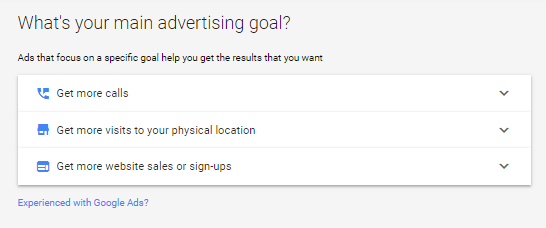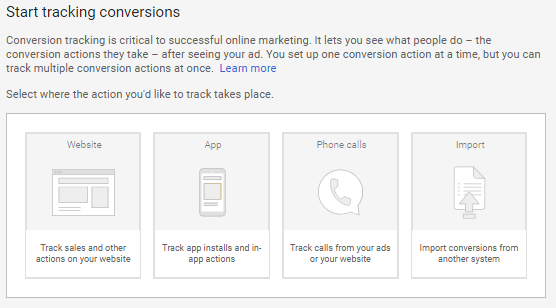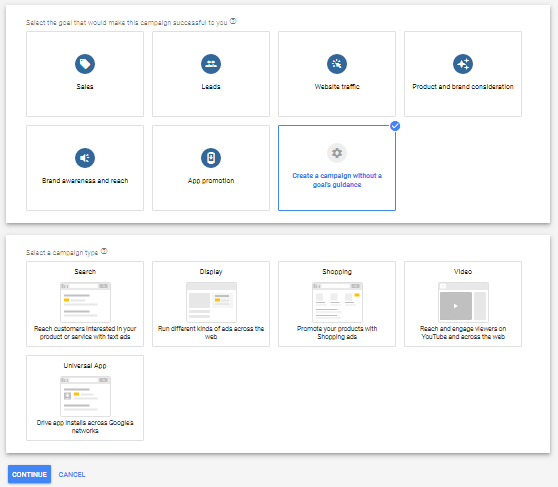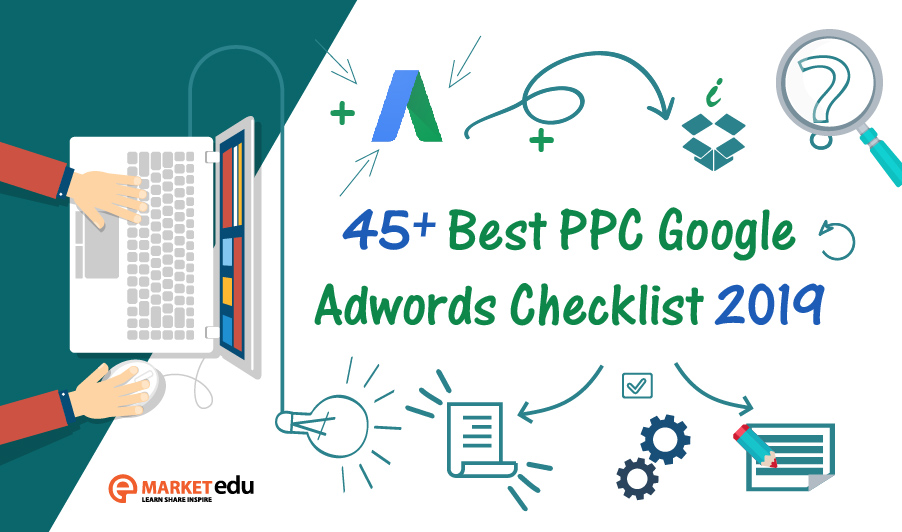Top PPC Checklist
Here’s 45 Google Adwords Setup checklist to help in the process of PPC Google Adwords Account & Campaign Setup, initial PPC implementation & management process to overcome any basic complexities in PPC Google AdWords optimization list;
Initial PPC Adwords Account & Campaign Checklist;
-
- Nowadays, when you start setting up your first Google Ads account, it would ask you to setup Google Ads Express account; Link to setup the Google Ads Express Here
- Define your advertising goal out of 3 options for which you want to run the Google Ads campaign;

- Once you select any one of the 3 options, you will be asked to complete this 4 actions

- Once you have completed all the 3 actions, you will be asked to complete the billing details
- If you choose US, it would ask for either Credit/Debit/Bank Account details
- If you choose India, it would ask for either Automatic/Manual payments
- In automatic, it would be only credit card details
- In manual, you will find different options including credit/debit/netbanking and few other options
- Once you have completed all the 4 actions, you can then have access to the main PPC Google Ads Interface, other than the Google Ads Express
- Click here to know: Difference between PPC Google Ads Main Interface vs PPC Google Ads Express
- Many of the beginners or professionals forget to pause the Google Ads Express account after having access to main Google Ads Interface, and they don’t realize that campaigns at both levels are taking away cost; so if you aren’t dependent on Google Ads Express, then make sure you pause all the campaigns that was created in order to get an entry to the Google Ads Main Interface
- If finding difficulty to move from AdWords Express to Google Ads, click this link of Google Ads Interface
- Once you access the PPC Google Ads Main Interface, click on the ‘Tools” tab to check the following features are properly setup;
- Billing & Payment
- Account Access
- Linking Account to Google Analytics, Google Webmaster, YouTube & other necessary platforms, if you want those platforms data metrics to be a part of reference in your AdWords interface for optimization
- Integrating/linking Google Google Merchant Center too for running Shopping Ads (or formerly called Product Listing Ads (PLA))
- Generating Google Ads Conversion Tracking code for any one or all of the below actions including Website sales or leads actions, App Installation or In-App actions, Phone Calls tracking from Ads or Website action, and Import Conversion action from other system

- Don’t forget to add the conversion tracking code in the goal/thank you page of your website
- Generating Remarketing Code for Audience targeting by clicking the “Tools” tab again, and next clicking “Audience Manager” under “Shared Library Column
- Recommended to create PPC Adwords campaign structure with excel initially than directly implementing the interface. It’s important to save all task in a folder. Hubspot created a great free AdGroups template. Download it from their website
- Be very clear with your goal or objective focusing which you need to define your campaign network selection including Search, Display, Shopping, Video & Universal App targeting

- Define target location (country, region, city or radius targeting) for each of your PPC AdWords campaigns
- Define every campaign’s budget based on Client’s target objective, significance, ROI expectation, location, and devices. For e.g., Brand needs less budget compared to Generic campaign with a bit higher budget than to Brand, and product/service specific campaign with a much higher budget, as they are your main goal meeting campaigns
- PPC Google Ads Campaign daily budget should be higher than keyword Max CPC
- Default Bid/Max CPC bid should be clearly defined at either Adgroup or Keyword level. Adgroup defined bids will be applied to keywords, if keyword bids are not mentioned
- Important Google AdWords Campaign settings, while going live with new campaigns;
- Ad Delivery – Accelerated delivery for a higher frequency of ad occurrence
- Delivery Method – your ad should be in “rotate evenly” mode initially
- Ad Scheduling – specifying to run your ads only during a certain time of the day or given days of the week
- Enable Auto Tagging “YES” by following the given steps. Open www.google.com/adwords, then Go to Account Settings – Preferences – Edit Auto Tagging Tab in Adwords Interface & select “Yes”. When done, it would help to track the AdWords performance in Google Analytics interface automatically.
- If auto-tagging is not changed to YES, then you have to manually tag the keyword performance in Google Analytics by generating tags from Google Analytics URL Builder tool.
- Keyword Planner Tool is used to identify new keywords, negative keyword ideas, performance stats, trends, adgroup ideas for grouping keywords into themes.
- Decide on right Keyword Match Type key phrases for all adgroup keywords – experiment with all PPC match types but recommended using the modified broad match to start with, while closely monitoring. Here’s a video on Google Ads Keyword Match Type Best Practices
- Understand PPC metrics; http://www.slideshare.net/ranjanraji/ppc-google-adwords-metrics
- Search Query Report can be generated by clicking on: (Under Keyword Tab -> View -> Search Term) Helps you generate new keywords idea along with negative keyword list too. It has also got performance stats to help you analyze and confirm if your decision of choosing new keywords will help you to achieve the goal or not?
- Ads for every ad group in the form of Text | Image | Videos | Rich Media | Dynamic | Shopping Ads (Best Practices)
- Limit the number of ad copies to 3 in an adgroup.
- Adcopy character limits (Headline (1,2,3) = 30, Description Line (1,2) = 90, Path (1,2) = 15, Final URL=1024). Note: Always prescribe destination URL at the Adcopy level.
- Use keyword in Path 1 & Path 2 of Display URL
- Any modification in the existing adcopies, would lead to losing of history or quality score thus impacting the performance
- Advisable to try new adcopy every month
- Adding to either ! or . in the description line 1, would place your line 1 next to Headline if your ads are in 1-2-3 ad ranking
- Create Adgroup with common theme keywords ideas with a max of 15-20 keywords to create specific/relevant ad copies while directing to specific landing pages in order to build a high quality score
- Deep linking Destination URL – Define each of your keywords adcopies to the specific landing page than sending to Home page every time
- Use Sitelinks Ad Extensions for Brand & Competitors campaigns, as the chances of showing in 1-2-3 are much higher than to Generic or Specific campaigns, where competition is regular
- Dynamic Keyword Insertion adcopies shouldn’t be used for Competitor specific campaigns as it may lead to trademark violations. And try using less for Brand campaigns, as it might not help you much, since you can have a strong Brand specific ads by yourself than depending on DIK.
- For Display Network campaigns, the keywords bids should be reduced to 1/3rd of the Search Network or start with a very nominal bid, as it can exhaust your budget quickly
- Don’t miss out to run Google remarketing campaign along with Search & Display campaigns, since it helps to target the existing customer regularly
- Quality Score of Display Network will not impact the Quality Score of Search Network
- Ad Rank = Max CPC * Quality Score
- Quality Score is calculated every time your ads is for auction
- Change History feature under “Tools” tab helps you to check the changes made by others
- Use Ad preview and Diagnostics tool to check ad copy status and;
- Where your keyword ads are positioned
- The advantage is, it won’t add impression to the account performance
- Adwords Editor helps you to work on account campaigns offline, in bulk uploading of either Campaigns, Adgroups, Keywords or Ad copies along with large optimization changes in sec/min
- Use right Bid Strategy under Campaign Settings, and make proper use of Enhanced CPC feature
- While uploading the keywords through Adwords Editor, avoid keywords over 10 words length limit
- Use labels for campaigns, ad groups, keywords and ad copies in order to check the performance independently than calculating everything
- Save all the upload, analysis files for future reference with correct date-month-filename-username etc.,
- Always be testing!
For any PPC training in Bangalore , contact eMarket Education at +91-7760969452








Add Comment